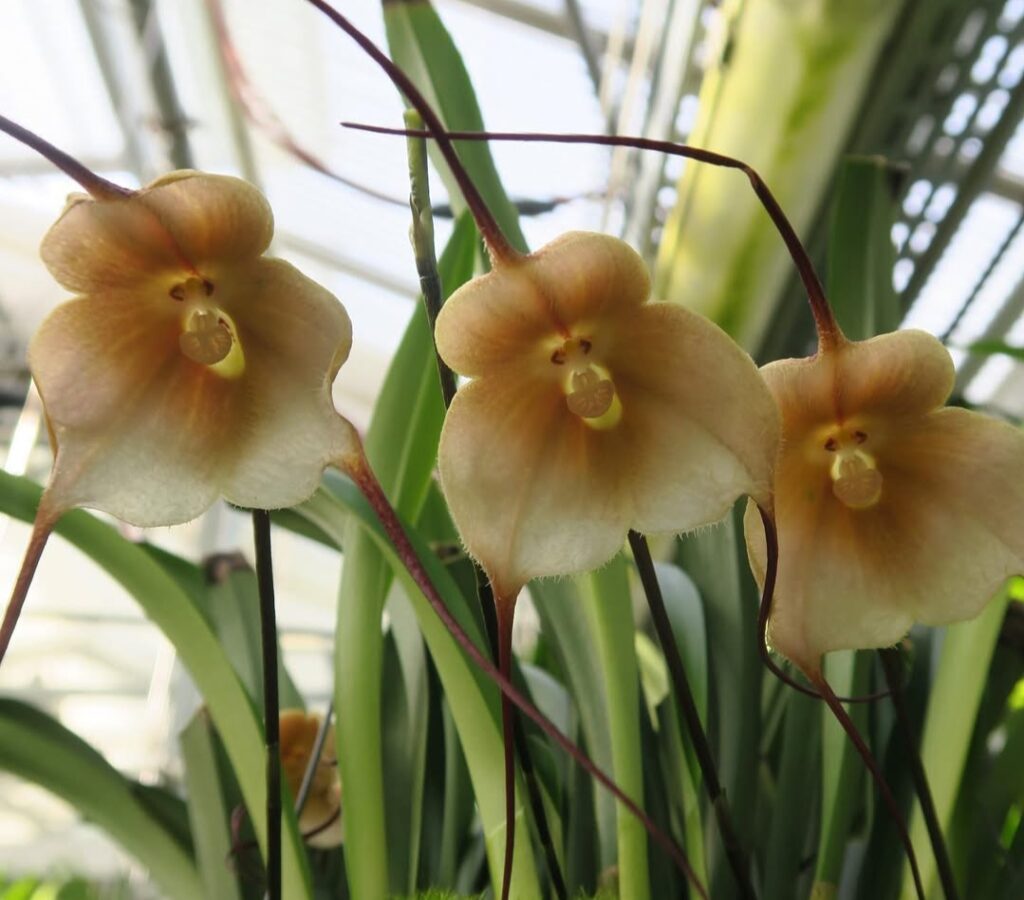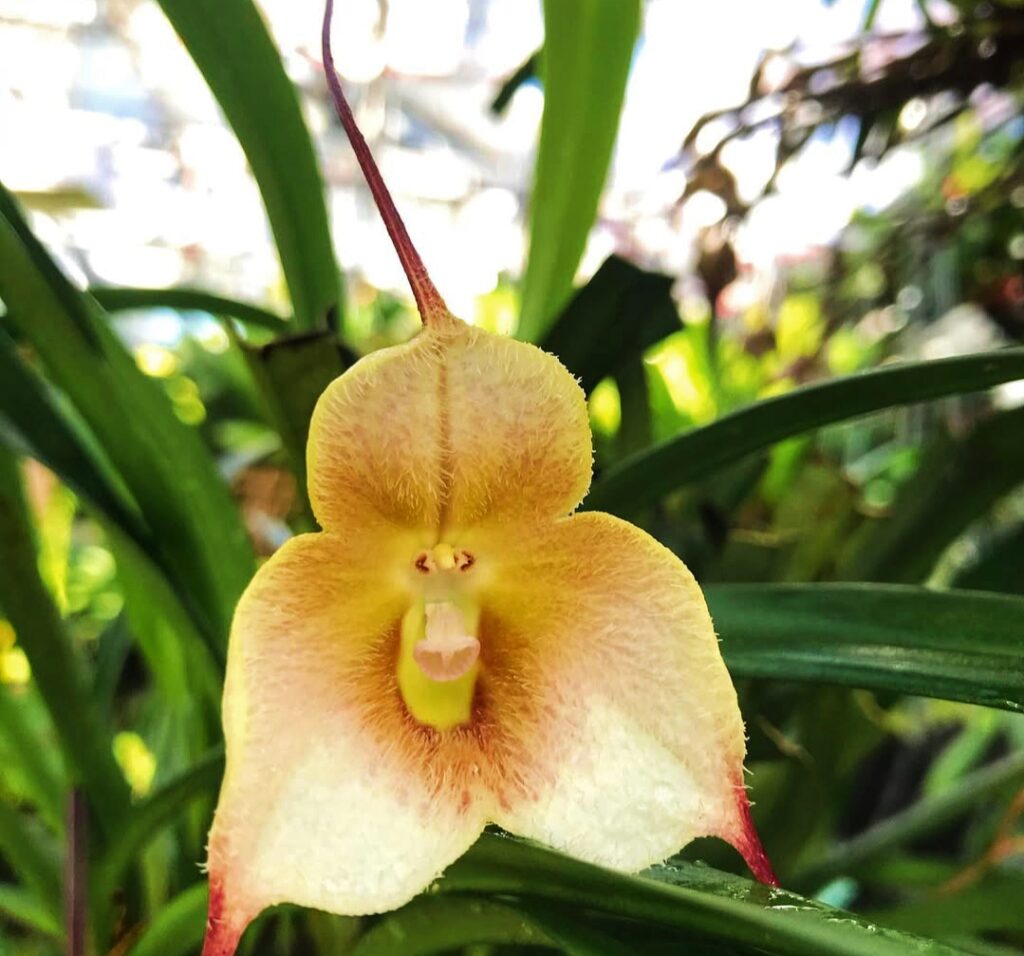Dracula Amaliae orchids, often referred to as the “Monkey Face Orchid” due to their unique appearance, are a fascinating and rewarding species for orchid enthusiasts. Native to the cloud forests of Ecuador and Colombia, these orchids thrive in cool, high-humidity environments, making them ideal for greenhouse cultivation or terrariums
Known for their stunning, pendulous blooms and intriguing facial-like patterns, Dracula Amaliae orchids can be a bit challenging to care for, but with the right attention, they can flourish and reward you with their exotic beauty. In this guide,

we’ll cover everything you need to know about how to care for Dracula Amaliae orchids, from their ideal growing conditions to tips for keeping them healthy and blooming. Whether you’re a beginner or an experienced grower, these tips will help you provide the perfect environment for this remarkable orchid.
Light:
These orchids prefer low to medium light levels. Ideally, they should be placed near a north-facing window or under fluorescent lights. Direct sunlight can burn their leaves, so avoid placing them in direct sunlight. When it comes to light requirements, Dracula amaliae prefers filtered or diffused light. Direct sunlight can harm the plant and cause leaf burn.
In nature, the plant grows in the shade of taller trees, so replicating this environment in cultivation is ideal. Indoors, Dracula amaliae can be grown near an east-facing window, where it can receive bright but indirect light in the morning, but is shaded from the stronger afternoon sun. Alternatively, artificial lighting can be used to provide the necessary light levels for the plant’s growth.Overall, Dracula amaliae requires moderate light levels and can thrive in a range of lighting conditions, as long as they are not too intense or too dim.
Temperature:
Dracula Amaliae orchids prefer cool temperatures, ranging from 55-70°F (13-21°C) during the day and slightly cooler at night. They should be kept away from heaters, air conditioners, and drafts.
Dracula amaliae is a cool-growing orchid species and is adapted to the cool, humid conditions found in the mountain cloud forests of South America. As a result, it has specific temperature requirements for optimal growth and development.
During the day, Dracula amaliae prefers temperatures between 18°C (64°F) to 24°C (75°F). At night, it prefers cooler temperatures, around 10°C (50°F) to 15°C (59°F), with a maximum of 18°C (64°F). This means that Dracula amaliae prefers a temperature differential between day and night, and can tolerate a temperature range of around 8°C to 14°C (14°F to 25°F) between day and night.
To provide the optimal temperature range, it is important to maintain consistent temperatures and avoid sudden fluctuations. This can be achieved by placing the plant in a cool, shaded area with good ventilation, such as near an open window, but not in direct sunlight or drafts.In general, Dracula amaliae requires cool to intermediate temperatures to grow and thrive, and it is important to provide these conditions to ensure healthy growth and blooming.
Humidity:
These orchids require high humidity levels, ideally between 70 and 80%. This can be achieved by placing a humidifier near the plants or by using a tray filled with water and pebbles underneath the plant. Dracula amaliae is a high-elevation, cloud forest orchid species that requires high humidity levels to thrive. In their natural habitat, they grow in humid and moist environments, with mist and fog being a regular occurrence. Therefore, providing the proper humidity levels is essential for healthy growth and flowering.
To meet its humidity requirements, Dracula amaliae needs a humidity level of 60-80%. This can be achieved by placing the plant in a humid area, such as a terrarium or greenhouse, where humidity levels can be maintained. Alternatively, regular misting or placing a tray of water nearby can also help to increase humidity levels.
It’s important to note that too high humidity levels can also cause issues such as bacterial and fungal growth, so it’s important to maintain consistent humidity levels without overwatering or creating stagnant air.
Overall, providing high humidity levels is crucial for the growth and health of Dracula amaliae, and it’s important to monitor and adjust humidity levels accordingly to ensure its proper development.
Watering:
These orchids should be watered thoroughly once a week. Make sure to let the soil dry out slightly between watering to prevent root rot. During the growing season, you can increase watering frequency to twice a week. Dracula amaliae is an epiphytic orchid that grows naturally in cloud forests where it receives regular moisture from mists and rainfall.
As such, it requires consistent but moderate watering to thrive in cultivation.When watering Dracula amaliae, it is important to ensure that the potting medium is evenly moist but not waterlogged. Overwatering can lead to root rot and other fungal diseases, which can quickly kill the plant. On the other hand, allowing the potting medium to dry out completely can cause the plant to wilt and suffer from dehydration A good rule of thumb for watering Dracula amaliae is to water the plant thoroughly once a week, allowing excess water to drain out of the pot.
The frequency and amount of water may need to be adjusted based on the plant’s specific growing conditions, such as humidity and temperature.It is also important to note that Dracula amaliae does not tolerate hard water or mineral buildup in the potting medium. To prevent this, it is recommended to use distilled or rainwater for watering, or to flush the potting medium regularly with clean water to remove any buildup.
Fertilizer:
These orchids require regular fertilization during the growing season. Use a balanced orchid fertilizer every two weeks. During the dormant season, fertilization should be reduced to once a month.
Dracula amaliae is an epiphytic orchid species that has adapted to grow in nutrient-poor environments. As such, it has low fertilizer requirements, and too much fertilizer can harm the plant. However, providing some fertilizer is still necessary to support the plant’s growth and flowering.
When fertilizing Dracula amaliae, it is important to use a balanced, water-soluble orchid fertilizer that is specifically formulated for epiphytic orchids. This type of fertilizer typically has a higher concentration of nitrogen, which promotes leaf and stem growth, as well as lower concentrations of phosphorus and potassium, which support root development and flowering.
It is recommended to fertilize Dracula amaliae once every two weeks during the growing season, which typically starts in early spring and ends in late summer or early fall. During the dormant season, which occurs in late fall and winter, fertilization can be reduced or stopped altogether.
When applying fertilizer, it is important to follow the instructions on the label carefully, and to avoid over-fertilizing. Over-fertilizing can lead to fertilizer burn, which can cause the plant’s roots to die and can harm the plant. It is also a good idea to flush the potting medium with clean water periodically to prevent salt buildup from the fertilizer.
Potting and Repotting Dracula Amaliae Orchids:
Potting Mix: Use a well-draining orchid mix, typically consisting of fine bark, perlite, and sphagnum moss. Dracula orchids prefer slightly moist conditions but do not like waterlogged roots.
Container: Choose a pot with good drainage holes. It’s best to use a plastic or clay pot, as they both allow the roots to breathe while keeping moisture in check.
Repotting Frequency: Repot every 1-2 years, ideally after the plant finishes flowering. If the potting medium starts to break down or the roots outgrow the pot, it’s time to repot.
Repotting Process: Gently remove the orchid from its pot, trim any damaged or dead roots, and place it in the new pot with fresh medium. Ensure the roots are spread evenly and not crowded.
Common Pests:
Mealybugs: These pests can be found on the plant’s leaves and roots. They look like white, cotton-like masses. Use insecticidal soap or a cotton swab dipped in rubbing alcohol to treat infestations.
Scale Insects: These pests appear as small, brown, oval-shaped bumps on the leaves and stems. Scale can be treated with insecticidal soap or by scraping them off with a soft brush.
Aphids: Aphids are small, green or black insects that can be found on the new growth. They can be removed by spraying the plant with a mild soapy water solution.
Fungus Gnats: These tiny flying pests are attracted to the moist environment around the roots. Reduce watering and use yellow sticky traps to capture the adults.
Common Problems:
Root Rot: Dracula orchids are sensitive to overwatering. If the roots are mushy or the plant is wilting, root rot may be the issue. Ensure the potting medium drains well and the plant is not sitting in stagnant water.
Yellowing Leaves: This can be caused by overwatering, underwatering, or nutrient imbalances. Make sure the plant has proper watering habits, and ensure it’s not exposed to drafts or extreme temperatures.
Poor Flowering: Insufficient light can cause poor flowering. Dracula orchids thrive in lower light conditions, so ensure they’re not in direct sunlight, which can scorch the leaves. Additionally, a consistent night temperature drop (around 10°F lower than day temperatures) helps promote blooms.
Leaf Spots: Spots or lesions on the leaves could be a sign of fungal or bacterial infections. To prevent this, avoid getting water on the leaves and ensure the plant has good air circulation.
Regular maintenance of these factors will help keep your Dracula amaliae healthy and blooming.
FAQs on caring for Dracula Amaliae orchids:
What is the ideal temperature range for Dracula Amaliae orchids?
Dracula Amaliae orchids prefer cooler temperatures. The ideal range is between 60°F to 70°F (15°C to 21°C) during the day and 50°F to 60°F (10°C to 15°C) at night.
How often should I water Dracula Amaliae orchids?
Water your Dracula Amaliae orchids every 4-7 days, depending on the humidity and temperature. Ensure the growing medium is moist but not soggy, and avoid letting the roots sit in standing water.
What type of light do Dracula Amaliae orchids need?
These orchids thrive in low to moderate light. Place them in an area with filtered or indirect light, such as near an east or north-facing window
How should I fertilize Dracula Amaliae orchids?
Fertilize your Dracula Amaliae orchid once a month with a balanced, water-soluble orchid fertilizer. Dilute the fertilizer to half strength to avoid overfeeding.
Do Dracula Amaliae orchids need high humidity?
Yes, Dracula Amaliae orchids require high humidity levels of 60% to 80%. Consider using a humidity tray or a humidifier to maintain the right environment.
What type of potting mix is best for Dracula Amaliae orchids?
Use a well-draining orchid mix containing bark, sphagnum moss, and perlite. This ensures the roots receive adequate air circulation and prevents rot.
How can I encourage Dracula Amaliae orchids to bloom?
To encourage blooming, provide consistent cooler temperatures, high humidity, and avoid disturbing the orchid during the blooming period. Patience is key, as blooms tend to appear in late fall to early winter.
How do I repot Dracula Amaliae orchids?
Repot Dracula Amaliae orchids every 1-2 years, ideally during the spring or after blooming. Gently remove the orchid from its pot, inspect the roots, and place it in a slightly larger pot with fresh, well-draining orchid mix.
Why are the leaves of my Dracula Amaliae orchid turning yellow?
Yellowing leaves can indicate overwatering, poor drainage, or low light. Ensure you’re following the correct watering schedule and providing adequate light.
Can Dracula Amaliae orchids tolerate drafts?
No, Dracula Amaliae orchids do not tolerate drafts. Keep them away from air vents, open windows, or direct air circulation that could cause stress to the plant.

